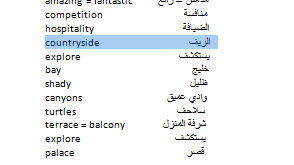الدميه الروسيه
هذه القطعة تأتي أحياناً في اختبار الكفايات
The first Russian nested doll set was carved in 1890 by Vasily Zvyozdochkin and designed by Sergey Malyutin who was a folk crafts painter in the Abramtsevo estate of Savva Mamontov, a Russian industrialist and patron of arts.[3][4]
The doll set was painted by Malyutin. Malyutin’s doll set consisted of eight dolls—the outermost was a girl in a traditional dress holding a rooster. The inner dolls were girls and a boy, and the innermost a baby
.
Zvyozdochkin and Malyutin were inspired by a doll from Honshu, the main island of Japan. Sources differ in descriptions of the doll, describing it as either a round, hollow daruma doll, portraying a bald old Buddhist monk,[5] or a Seven Lucky Gods nesting doll.
Savva Mamontov’s wife presented the dolls at the Exposition Universelle in Paris, where the toy earned a bronze medal. Soon after, matryoshka dolls were being made in several places in Russia and shipped around the world.
Themes in dolls
known as a Russian nesting doll, Stacking dolls, or Russian doll,[1] is a set of wooden dolls of decreasing size placed one inside another. The name “matryoshka” (матрёшка), literally “little matron”, is a diminutive form of Russian female first name “Matryona” (Матрёна) or “Matriosha”.[2]
A set of matryoshkas consists of a wooden figure which separates, top from bottom, to reveal a smaller figure of the same sort inside, which has, in turn, another figure inside of it, and so on.
The first Russian nested doll set was made in 1890 by Vasily Zvyozdochkin from a design by Sergey Malyutin, who was a folk crafts painter at Abramtsevo. Traditionally the outer layer is a woman, dressed in a sarafan, a long and shapeless traditional Russian peasant jumper dress. The figures inside may be of either gender; the smallest, innermost doll is typically a baby turned from a single piece of wood. Much of the artistry is in the painting of each doll, which can be very elaborate. The dolls often follow a theme; the themes may vary, from fairy tale characters to Soviet leaders. Matryoshka dolls are often referred to as “babushka dolls“, babushka meaning “grandmother” or “old woman”.
Matryoshka dolls[7] are often designed to follow a particular theme; for instance, peasant girls in traditional dress. Originally, themes were often drawn from tradition or fairy tale characters, in keeping with the craft tradition—but since the late 20th century, they have embraced a larger range, including Russian leaders.
Modern artists create many new styles of nesting dolls. Common themes include floral, Christmas, Easter, religious, animal collections, portraits and caricatures of famous politicians, musicians, athletes, astronauts, “robots,” and popular movie stars. Today, some Russian artists specialize in painting themed matryoshka dolls that feature specific categories of subjects, people or nature. Areas with notable matryoshka styles include Sergiyev Posad, Semionovo (now the town of Semyonov),[8] Polkhovsky Maidan, and Kirov.
Political MatryoshkaEdit
In the late 1980s and early 1990s during Perestroika, freedom of expression allowed the leaders of the Soviet Union to become a common theme of matryoshka, with the largest doll featuring then-current leader Mikhail Gorbachev.
These became very popular at the time, affectionately earning the nickname of a “Gorby”, namesake of Gorbachev. With the periodic succession of Russian leadership after the collapse of the Soviet Union, newer versions would start to feature Russian presidents Boris Yeltsin, Vladimir Putin, and Dmitry Medvedev.
Most sets feature the current leader as the largest doll, with the predecessors decreasing in size. The remaining smaller dolls may feature other former leaders such as Leonid Brezhnev, Nikita Khrushchev, Joseph Stalin, Vladimir Lenin, and sometimes several historically significant Tsars such as Nicholas II and Peter the Great. Yuri Andropov and Konstantin Chernenko almost never appear due to the short length of their respective terms. However, some less common sets may feature the current leader as the smallest doll, with the predecessors increasing in size, usually with Stalin or Lenin as the largest doll.
Some sets that include Yeltsin preceding Gorbachev were made during the brief period between the establishment of President of the RSFSR and the collapse of the Soviet Union, as both Yeltsin and Gorbachev were concurrently in prominent government positions. During Medvedev’s presidency, Medvedev and Putin may both share the largest doll due to Putin still having a prominent role in the government as Prime Minister of Russia. As of Putin’s re-election as the 4th President of Russia, Medvedev will usually succeed Yeltsin and preceded Putin in stacking order, due to Putin’s role solely as the largest doll.
Political matryoshka usually range between 5 and 10 dolls per set.
World recordEdit
The largest set of matryoshka dolls in the world is a 51-piece set hand-painted by Youlia Bereznitskaia of Russia, completed in 2003. The tallest doll in the set measures 53.97 centimetres (21.25 in); the smallest, 0.31 centimetres (0.12 in). Arranged side-by-side, the dolls span 3.41 metres (11 ft 2.25 in).[9]
As metaphorEdit
Matryoshkas are used metaphorically, as a design paradigm, known as the “matryoshka principle” or “nested doll principle”. It denotes a recognizable relationship of “object-within-similar-object” that appears in the design of many other natural and crafted objects. Examples of this use include the matrioshka brain, the Matroska media-container format, and the Russian Doll model of multi-walled carbon nanotubes.
The onion metaphor is of similar character. If the outer layer is peeled off an onion, a similar onion exists within. This structure is employed by designers in applications such as the layering of clothes or the design of tables, where a smaller table nests within a larger table, and a smaller one within that.
 بلبل انقلش لتعليم اللغة الإنجليزية
بلبل انقلش لتعليم اللغة الإنجليزية





